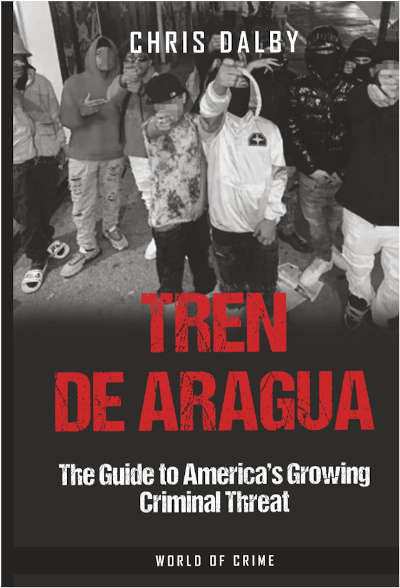En la imagen
Cover of ‘Tren de Aragua: The Guide to America’s Growing Criminal Threat’, by Chris Dalby (World of Crime, 2025), 279 pages
It is no longer possible to dismiss Tren de Aragua as a marginal Venezuelan gang. What began as a prison-based syndicate in Tocorón—where criminal bosses turned their penitentiary into a surreal stronghold with nightclubs, kids playgrounds, pools, and even a zoo—has evolved into a sprawling transnational enterprise. Tren de Aragua thrives on human trafficking, extortion, illicit gold mining, and drug smuggling. Its expansion across Latin America, and now its presence in the United States, places it at the center of political debates about migration and security. Today, the transnational gang embodies both the fragility of Latin American statehood and the global reach of modern organized crime.
The author of this book, Chris Dalby, is not new to these phenomena. A veteran journalist and founder of the ‘World of Crime’ platform, Dalby has specialized in mapping criminal ecosystems across the Americas. His reporting style succeeds in avoiding the sensationalism that often distorts discussions of gangs and cartels. This volume on Tren de Aragua is the latest in his ‘World of Crime’ series, and it benefits from the same deep sourcing and comparative perspective that has made his earlier works essential reading for anyone following the evolution of organized crime.
The book itself is structured as a thematic guide rather than a linear narrative. Each chapter can stand on its own—whether it is examining Tocorón prison as a criminal fortress, the gang’s penetration into Chile and Colombia, or the ways it monetizes migration corridors. But when read sequentially, the book forms a coherent picture of a network that simultaneously holds centralized power under figures like ‘Niño Guerrero,’ and fragmented into semi-autonomous franchises. Dalby does not only chart what the gang does; he shows how it adapts, mutates, and sometimes even inspires copycats who use the Tren de Aragua name as a brand of fear.
A defining strength of the book lies in its nuanced depiction of Tren de Aragua, resisting the temptation to flatten it into just another stereotype Latin American cartel. Dalby stresses that the gang is “neither a monolithic organization, nor non-existent. Instead, it has evolved into something altogether more layered—a criminal brand-for-hire.” This layered reality complicates both policy and law enforcement responses. For instance, while Venezuelan President Nicolás Maduro has claimed the group no longer exists, US authorities have gone in the opposite direction, officially labeling it a terrorist organization in February 2025. The Trump administration justified the designation by citing its “campaign of violence and terror” across the Western Hemisphere. Dalby carefully dissects the implications of this strategic move, pointing out both its political utility in immigration debates and its legal consequences for Venezuelan migrants, some of whom are now being denied asylum because they were forced to pay extortion fees to the gang in question.
Two aspects of Dalby’s analysis are particularly compelling. The first is his skill in weaving together local testimonies with broader geopolitical dynamics, illustrating how Tren de Aragua’s local-level extortion in border towns is actually inseparable from wider regional security shifts. The second is his focus on state involvement: rather than portraying this transnational gang as an outside predator, the author situates its success within Venezuela’s gray zone, where authorities either enabled, profited from, or were proved unable to confront it. This nuanced perspective pushes readers to think about organized crime not only as an enemy of the state, but also as a distorted byproduct of state failure.
Ultimately, the book succeeds in providing clarity where confusion reigns. Media portrayals have swinged between exaggeration—painting the gang as an unstoppable cartel poised to engulf US cities—and minimization, treating it as just another Venezuelan export. Dalby strikes a balance. He acknowledges Tren de Aragua’s brutality and reach, while warning against its instrumentalization in domestic political battles. What makes ‘Tren de Aragua: The Guide to America’s Growing Criminal Threat’ stand out is that it does not merely chronicle crimes. It shows how a gang, born from Venezuela’s collapse, reflects broader challenges of migration, governance, and regional insecurity today. Dalby’s work is more than reportage—it is a guidebook for understanding a phenomenon that is reshaping the criminal map of the Americas. If policymakers, scholars, and the public want to grasp why a Venezuelan prison gang now appears in headlines from Bogotá to Baltimore, this is the book that provides the indispensable context.

